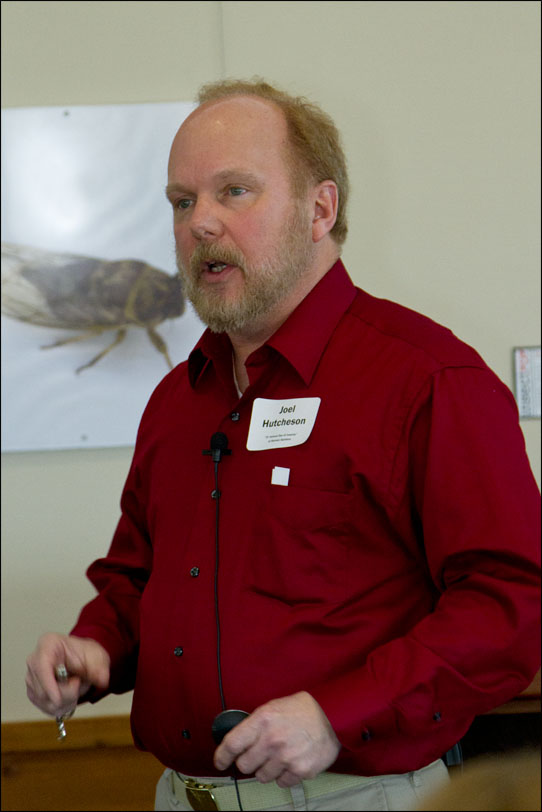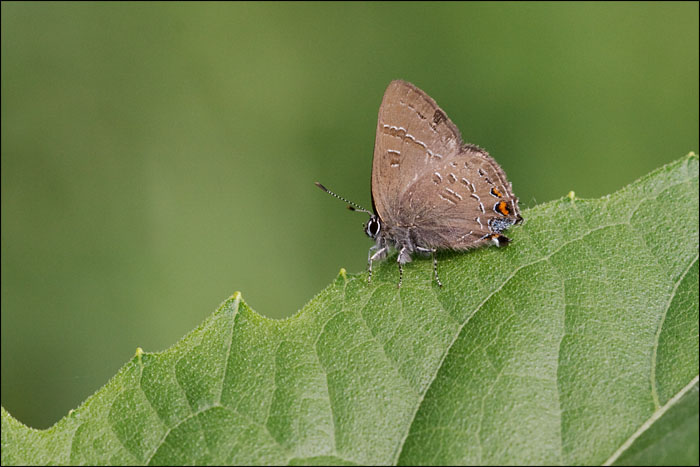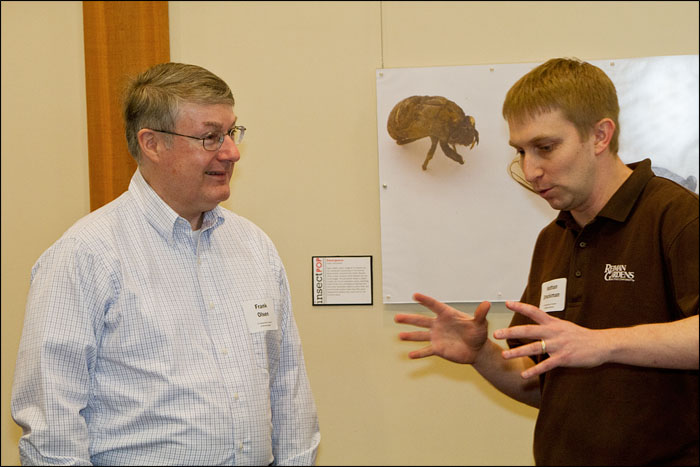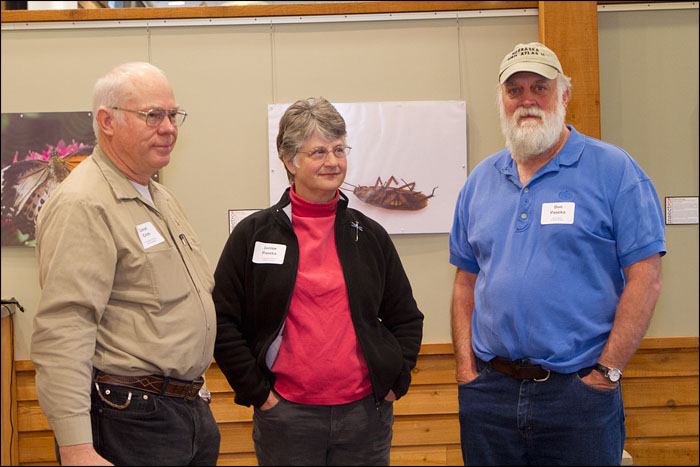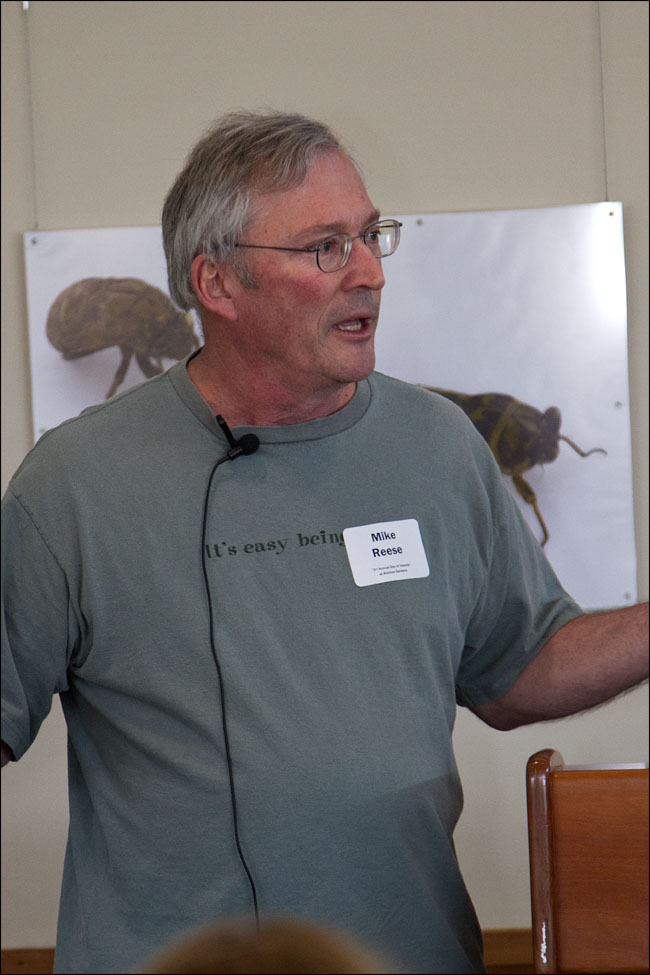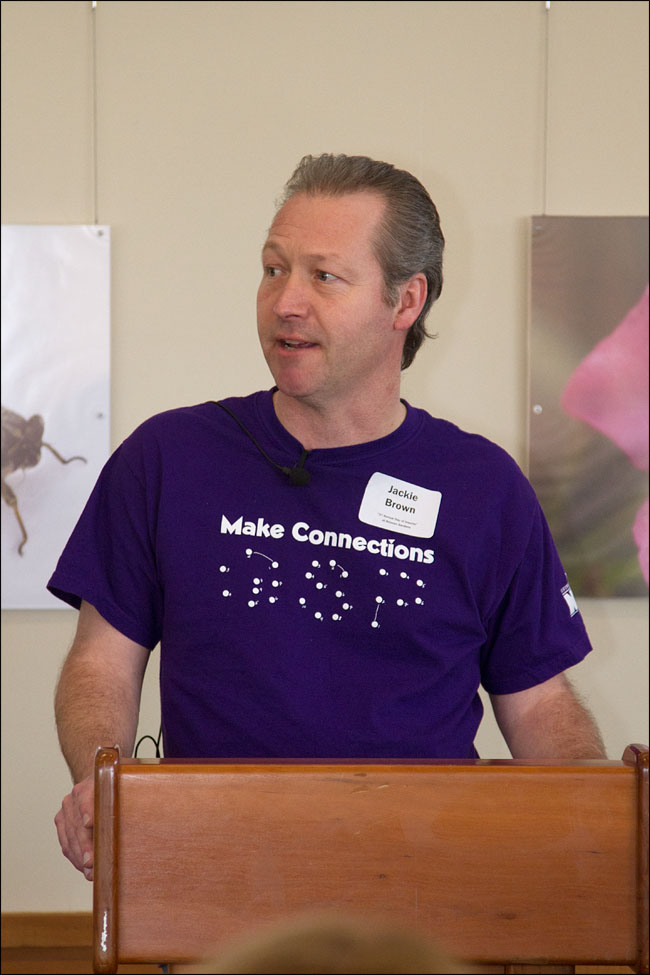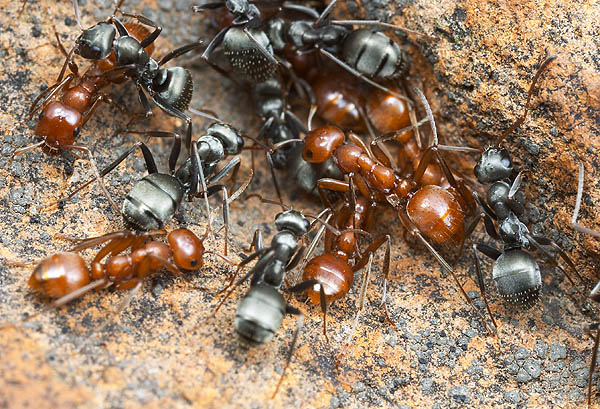by Marcie O’Connor and Laura Winkler, photos by Robert & Linda Scarth
The 3rd annual Day of Insects was held at Reiman Gardens, in Ames, Iowa. The event was organized by Nathan Brockman and MJ Hatfield.
There was a dinner the night before, at Sylvia Carter’s – she had us all rolling out pita bread, while she cooked and her parrot (Kermie) watched from convenient shoulders.
Day of Insects began the next morning. Each talk was 15 minutes long with 5 minutes for questions. Here are the presenters, with short summaries of their talks.
Venomous Invertebrates: ‘the Good, the Bad and the Ugly’ – William Heyborne, Morningside College
Venoms are toxic substances that are made in a specialized organ and are delivered during biting or stinging.
Venoms are used by many different kinds of invertebrates – probably evolved initially to subdue prey, but are also be used for defense.
Studying venoms has helped to increase understanding of predator-prey interactions, and led to the discovery of new biological molecules that have been used for various scientific and medical purposes.
Ticks of Iowa and Beyond – by Joel Hutcheson, USDA national Veterinary Services Laboratories, Ames
Most common ticks in Iowa are the Dog tick, Lonestar tick, and the Black-legged Tick (also called Deer Tick – the one that carries Lyme’s Disease).
Ticks are arachnids – mites – not insects. They are divided into two types – Hard and Soft Ticks. Hard Ticks females feed only once, and lay thousands of eggs. Soft tick females feed several times, and lay fewer – 100s – of eggs.
Ticks transmit more kinds of pathogens than other insects. Their bite can cause ascending paralysis which will subside if the tick is removed.
Hard ticks have between one and three different hosts – depending on the species. Soft ticks have many hosts, which means that there are more possibilities for disease transmission.
To avoid getting tick bites: wear light clothing so it’s easier to see the ticks. Tuck pants into socks – to keep the ticks away from your body. Stay out of wild places during peak tick times. And check for and remove ticks daily. Information about ticks and tick-borne diseases in Iowa can be found in a free publication from the ISU extension office.
Mantis Mania: An Introduction to the Art of Mantid Husbandry – by Joseph “Tony” Palmer, Omaha’s Henry Doorly Zoo
There are 20 Mantid species in North America. Two species that are found here are introduced. The Chinese Mantis is large, brought here for pest control in gardens. The European Mantis is smaller.
The only mantis native to Iowa is the Carolina Mantis. They have one generation a year, with the egg case overwintering.
Mantises can swivel their heads 180 degrees.
Males are slimmer, with wings that are longer than their abdomen, and have 8 abdominal segments. Females are fatter, with wings that are shorter than their abdomen, and have 6 abdominal segments.
Raising some species is very easy, some are very difficult. The more difficult ones usually require specific temperatures, humidity and air flow. Some can’t be kept with other mantises because they will eat each other. Some will only eat flying prey, others are less picky.
Come into Our Parlor – Arthropod Images by Linda & Robert Scarth
Linda and Bob try to increase peoples’ appreciation of the beauty of insects. They presented a 10 minute meditation on beautiful insects. It was a slide show of many of their wonderful photographs accompanied by a musical sound track. A quiet, beautiful break in the day.
Project Potpourri – by Royce Bitzer, Iowa State University
Royce talked about two of his projects:
First: The Vanessa Migration Project
Data on butterfly sightings from 2010, compared with weather maps, shows that Red Admirals migrated from southwest to northeast in the spring, ahead of cold fronts.
Second: Learning about the effects of Bt corn on non-target species by looking at the the spacial distribution of Carabidae (Ground Beetles) in a cornfield.
Iowa Tiger Beetles: Past and Present Diversity and Distribution, by Aaron Brees
Tiger Beetles occur in open habitats, take 3-4 years to reach maturity, mostly diurnal beetles. Their larvae are ambush predators – they make a hole, hide in it, and jump out at prey.
Most of the information about Tiger Beetles in Iowa is old – there’s information from the 1930s, and a bit from the 1970s. Aaron is trying to find which species are in Iowa now.
There are 4 genera in Iowa. Because they live in places that are impacted by human activities, many species are considered threatened. Many states have them listed for protection because populations are small and vulnerable.
Aaron has seen 8 species in Iowa, others have found a few more. So there are 10 species that have been found in the last 10 years. More photos of Iowa tiger beetles can be seen on Jim Durbin’s Insects of Iowa site, Matt Brust’s flickr site, and Ted McRae’s Beetles in the Bush blog. To read more about Aaron, and his natural history explorations, check out his web site.
Working out the Bugs – Insect ID pros and cons, by Moni Hayne, Bug Detective
Moni identifies photos of insects that people send in to a garden website: Simplegiftsfarm
The site asks for as much information as possible about the insect, including a photo. Sometimes she gets helpful information, sometimes not. It’s tricky to identify insects from fuzzy photos or scanty clues about habitat or behavior.
She feels that she helps people learn something about the insects they see, so they can either know it’s important to get rid of them, or feel more comfortable about having them around. She also enjoys the research she does on each insect, and the ways this adds to her own knowledge.
We had several breaks for food and drink – good times for conversation and getting to know the other insect folks.
Back to the talks…
Chasing Wisconsin Robbers: Our effort to learn more about the Asilidae, the robber flies of Wisconsin, by Mike Reese
Mike began his interest in insects by observing butterflies and starting a web site to document all the species found in Wisconsin. (WisconsinButterflies.org) He’s since expanded his interests and his web site to include first Tiger Beetles, and then Robber flies.
He showed many of his wonderful photographs of Robber flies – photos that display their amazing variety of shapes, mimicry, and prey species.
Evolution in Your Backyard by Jackie Brown, Grinnell College
Jackie is interested in getting people to appreciate insects, and to connect them with ideas that make some order out of nature. One of those ideas is evolution – the connection of natural selection with diversity – organisms interacting with each other in the world. If evolution is happening all around us, it should be happening in a way that we can see it.
The example he used to illustrate this is some research that was done on Eurosta solidaginis – a Goldenrod Gall Maker fly. It lays its eggs in a goldenrod stem in spring. The plant makes a characteristic round gall around the insect. The larva lives and feeds in the stem all summer, and overwinters as a larva, inside the gall.
Gall size is a heritable trait – so the researchers were interested in what kinds of predators preyed on the larvae, which size galls they targeted, and how that might affect gall size under different conditions. Birds – chickadees and woodpeckers – tended to prey on larger galls; parasitic wasps preyed on smaller galls. In looking at gall sizes over an large area, smaller galls were found to be more common near woodlands – where predation from chickadees and woodpeckers was more common; and larger galls were more common in open areas, where there tended to be more predation from parasitic wasps.
This response to predation could eventually result in a new species. For more information on Goldenrod Galls, their makers and predators, see this page on BugGuide, and this page by Dr. Warren Abrahamson and Paul Heinrich.
Sunflower Flies: hidden species in Iowa’s prairies presented by Ian McNish, on research done by Marty Condon, Cornell College, and Ian McNish, Pioneer Hi-Bred International
Sunflower flies are tiny flies that live on sunflower plants – Helianthus species. When put together in a closed petri dish, the flies show definite patterns of competitive behavior. Males fight each other, and sometimes females will fight. The victorious fly chases the loser around the petri dish – great video! Interestingly, the females don’t necessarily choose the victorious male. It may be that this behavior is territorial, so that the dominant males get the best territory, and thus the most or best females.
Science in Action is one of Marty’s citizen science projects.
What on Earth is This? Discovery and Description of a New Species, by Greg Courtney, Iowa state University
There is an incredible diversity of animals in the world – of the 2 million described animals – 1 million are insects. It’s estimated that there are 5-10 million animals total – which means that most animals – most insects – are still undescribed and unnamed.
There has been a decline in interest in this kind of exploration – discovering and naming new species – because people think we know about everything that’s out there. Also, people don’t think of it as science. Research has shifted to phylogenetics.
But it is important: There are many species we don’t anything about, and evolution and climate change is affecting species. We don’t know how much we don’t know.
Finding a new species can involve surveys, lab studies, and/or revisions of formerly identified groups of species. Once a new species is found, there are rules about how species are named. Most names are serious – species can be named after some characteristic of the organism, or for a person or a place. But there are some humorous names too.
Red Ants vs. Black Ants: The Dramatic Life of ‘Slave-Maker’ Ants, by James Trager, Shaw Nature Preserve
Ant species are much more complex that just red ants and black ants. One example is Red Polyergus ants which can’t survive without the labor of another species of ants that they enslave.
Polyergus ant queens invade the colony of a black Formica species. (different Polyergus species parasitize specific Formica species). The Polyergus queen may live for a while alongside the Formica queen, if the colony isn’t quite big enough. But once the population of workers is large enough, she will kill the Formica queen, and take over the colony. The Formica workers do the work of the colony – cleaning, bringing food, feeding the young. When the colony needs more workers, the Polyergus workers raid other Formica colonies and bring back young to be raised in the original colony, and turned into ‘slave’ workers.
This photo shows red Polyergus ants with their black Formica ‘slaves’ – photo from Alex Wild at myrmecos.net
A Honey Bee’s State of the State Address, by Andrew Joseph, Iowa Department of Agriculture and Land Stewardship
Attention to all the honey bee problems recently has encouraged more people to get into small scale bee keeping. There are several thousand bee keepers in Iowa, with 30,000 or so hives. Most keepers are small scale, but most hives belong to larger bee keepers.
Last year was a bad year for bee keepers – the US lost 34% of its hives over the winter, and Iowa lost 74%. This year is starting better, but the winter isn’t over yet.
In the mid 1980s, there were about 80,000 colonies in Iowa, producing about 80 lbs. of honey each; In the mid 1990s, 55,000 colonies, producing 66 lbs. of honey each. In 2010 there were 27,000 hives, producing about 49 lbs of honey per colony.
Right now most Iowa bees are in California, pollinating the almond crop. Some of the problems honey bees face:
Movement around the country – adds stress
Mixing with bees from other parts of the country, sharing pathogens, and then bringing them back to Iowa to be spread to other colonies.
When there are no crops for the bees to feed on, they’re often fed high-fructose corn syrup supplements – not very good for them.
Another problem for bee keepers is that most honey that’s sold in the US is from China. People are raising more bees, but not buying more US honey.
So the state of the state of honey bees isn’t very good right now.
Superorganisms: How Insect Societies Rule the Earth, by Amy Toth, Iowa State University
Insect societies have accomplished amazing things.
Eusociality describes the kind of societies present in many groups of insects. It includes overlap of generations, cooperative brood care, reproductive division of labor.
It’s like a factory in a fortress – the fortress is the guarded nest; the queen is the reproductive machine. Colonies act like one large organism – a superorganism. The individual animals live closely together – they can’t survive and reproduce without each other.
This kind of social organization can be found in ants, bees and wasps, but also termites, aphids, thrips, and some non-insects too – shrimps, and one mammal – naked mole rats.
There are a lot of these social insects – the biomass of ants is about equal to the biomass of humans on the earth.
These social insects can dominate an ecosystem. They have invented via evolution: agriculture, domestication, antibiotics, architecture, warfare, slavery, voting, and symbolic language. Pheromones are an important part of their communication system. There is no leader – they take their cues from the nest and their environment. Their collective intelligence resembles an organism.
It was a very interesting day, and a lot of fun.
After the talks were finished, some of the folks who were still in town went out to dinner together – another good time. And the next day some folks attended a malaise trap sort at CERA, near Grinnell, Iowa. It was fun to have more of a chance to talk, and to work together on an insect project.



